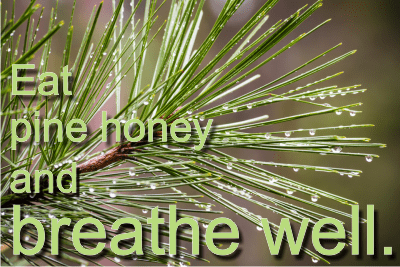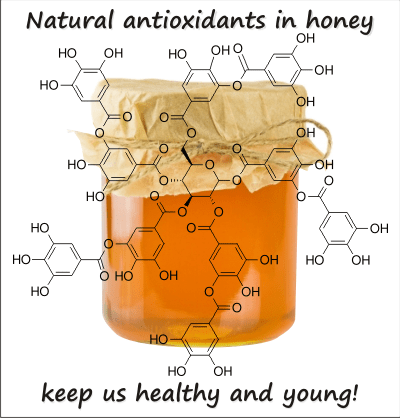Everybody knows a pine tree. Everybody loves it. Especially in winter. What we don’t know is that a honey can be made out of its sap. And that pine honey health benefits have a lot to do especially with our respiratory system. It’s expectorant and eases breathing. The best honey for lung diseases, chronic cough, asthma and bronchitis. And its benefits are even more.
Pines are evergreen, coniferous resinous trees in the genus Pinus, in the family Pinaceae. There are small pine trees, like the Siberian dwarf pine and Potosi pinyon or very tall trees, like the ponderosa pine located in southern Oregon’sRogue River-Siskiyou National Forest which is 268.35 feet (81.79 meter).
There are many species, but they are all divided into three subgenera, based on cone, seed and leaf characters:
– Pinus subg. Pinus, the yellow, or hard pine group, generally with harder wood and two or three needles per fascicle.
– Pinus subg. Ducampopinus, the foxtail or pinyon group;
– Pinus subg. Strobus, the white, or soft pine group, generally with softer wood and five needles per fascicle.
Honey can be made from all species, as the tree is attacked by aphids a lot. Only bees must be around!
Pine honey
The main coniferous honeydew honeys are produced from fir, spruce and pine trees. They are highly valued in different European countries. Greece is probably the most famous of them, as its pine honey is quite remarkable and represents 65% of the total honey production.
•Ikaria honey – the amazing Greek honey that holds the secret of a long life!
In central Europe, different honeydew honeys are all marked as forest honey. With the exception of French oak honey (Gonnet and Vache, 1998) and they are usually a mixture from different coniferous trees.
And there is also Metcalfa Honeydew honey, which is made by the honeydew produced by a special insect “metcalfa pruinosa”, giving a special type of honey with different characteristics.
Colour: brownish amber-dark amber
Flavor: malty, resinous, less sweet than other honeys
Intensity of flavor: medium-strong
Water content: low, under 18%
Viscosity: medium
Fructose content: 37%
Glucose content: 32%
Disaccharides content: 11%
Melezitose content: 3%
Maltose content: 9%.
pH: 4.6
Acidity: high
Mineral content: high, especially phosphorus, potassium, calcium, sulfur, magnesium, zinc, boron, iron, copper.
Crystallization: very slow, after 18 months in coarse crystals
Health benefits of pine honey
Pine honey has anti-inflammatory properties, it’s antioxidant, immunostimulant, cleanser, helps in the cure of some bacterial, dermatological, degenerative, inflammatory and autoimmune diseases.
When used externally it is beneficial for wounds and anti-rheumatic diseases.
It is also used against ovaries inflammation.
It is useful in respiratory conditions:
Used as an expectorant and breathing reliever for the lung diseases and chronic cough. Good for asthma and bronchitis. If the honey is consumed with the comb, it will have a bronchodilator effects.
It has antibacterial properties:
The study “ANTIBACTERIAL POTENTIAL OF HONEY FROM DIFFERENT ORIGINS: A COMPARSION WITH MANUKA HONEY“, by Sulaiman Alnaima et al. and published in The Journal of Microbiology, Biotechnology and Food Sciences in 2012, describes a comparison made between 18 honey varieties, both floral and forest honeys with manuka honey.
The results showed that Greek pine honey has a broad spectrum antibacterial activity (the peroxide type), followed by Scottish Heather, Chilean Ulmo, New Zealand Beech and Jarrah Honey. From all the tested bacteria, 4 of them were most sensitive to Greek pine honey: S.marcescens, and E. coli (with the highest sensitivity) B. sphaericus and B. subtilis.
It has anticancer properties:
In 2009, Tsiapara et al. investigated the influence of Greek honey extracts (thyme, pine and fir honey) on the oestrogenic activity and cell viability of breast (MCF-7), endometrial (Ishikawa) and prostate (PC-3) cancer cells. Thyme honey reduced the viability of Ishikawa and PC-3 cells, whereas fir honey stimulated the viability of MCF-7 cells. The authors concluded that modulation of oestrogen activity was linked to the rich phenolic content of Greek honeys and suggested that a thyme honey-enriched diet may prevent cancer related processes in breast, prostate and endometrial cancer cells.¹
It has strong antioxidant properties, compared to the more common floral honeys. So it will help in any condition that is determined by oxidation.
It helps in dermatological conditions:
For acne: Eat 6 teaspoons of pine honey. This type of honey will treat your acne which is caused by an imbalance of hormones, constipation or heavy accumulations of toxins in the body.
For open skin pores, we should apply a mixture made of 6 tablespoons of pine honey and 4 tablespoons from a decoction of willow bark (Boil 20 grams of willow bark in 100 ml of water for 10 minutes). The mixture is left on our complexion for half an hour to an hour, then removed with some carbonated water.
Repeat the treatment for 7 days in a row and you will see the results immediately.
For withered, aged skin apply a mask of simple pine honey for half an hour to one hour. Clean it with milk and then apply one of your usual cream. The treatment has to be done every evening, for 30 days. Meanwhile internally should be taken polifloral honey with royal jelly 2%. The effects are spectacular.
For cellulite, have a massage with honey mixed with a few drops of essential oil of lemon and/or orange. The mixture should be spread on the affected area and easily massaged. For 10 minutes the hands should be placed on the skin and then pulled up. The skin will be cleaned with warm water.
Where can we find PINE HONEY?
Try first at your locals, you may be surprised, who knows! Then try the online shops. Here are some great raw pine honeys that I recommend:
• From Greece: On Amazon.com almost all the pine honey comes from Greece. They do make an incredible honey there. Besides, they make honeys from different combinations of nectar. For example: an insanely good combination of pine and thyme honey, Pine & Thyme – Summer Honey From the Mountains of Crete, Greece. 250 g e / 8.82 oz, which is a traditional Cretan honey produced since the Minoan times and usually enjoyed on Greek goat yogurt.
With walnuts, of course. Greeks consider the mixture of this 3 as a guaranteed aphrodisiac.
• From the US. Yes, I know you are going to say that there is no honeydew honey in the US, but here it is, some pure pine honey from Virgin California: Raw Honey Local California US Choice – Yosemite Pine Honey – 24 oz


Pine honey is the perfect sweetener for a strong cup of black tea. We can also eat it on French toast and hot scones. Or, simply use it and add a little sweetness to savory dishes.
And have I mentioned sprinkled on Greek fat yogurt with walnuts? I guess I did….
=========================
=========================
I am in love with trees. Take a look at my collection of beautiful trees.
Follow Healthy ‘s board Trees on Pinterest.
References:
¹ TSIAPARA, A; JAAKKOLA, M; CHINOU, I; GRAIKOU, K; TINA TOLONEN, V V A P M (2009) Bioactivity of Greek honey extracts on breast cancer (MCF-7), prostate cancer (PC-3) and endometrial cancer (Ishikawa) cells: Profile analysis of extracts. Food Chemistry 116: 702-708.
Botanical species giving unifloral honey in Europe, by Livia PERSANO ODDO et al., Apidologie 35 (2004) S82–S93
CURATIVE MELLIFEROUS PLANTS IN TURKEY, by Orhan Kosi
http://ioanaginghina.blogspot.ro/2012/12/mierea-de-mana-de-brad.html
http://www.produsedeapicultura.ro/miere-de-albine/produse/1-miere-de-brad.html
http://www.healwithfood.org/health-benefits/pine-honey-buying-tips.php#ixzz3aJyQTqT6
http://sanatate.bzi.ro/beneficiile-mierii-de-mana-de-brad-11976
pine featured picture credit ewoerlen published under CC via flickr.com




